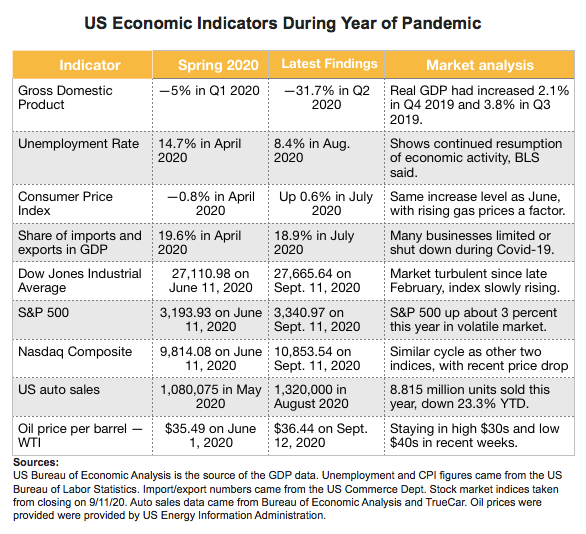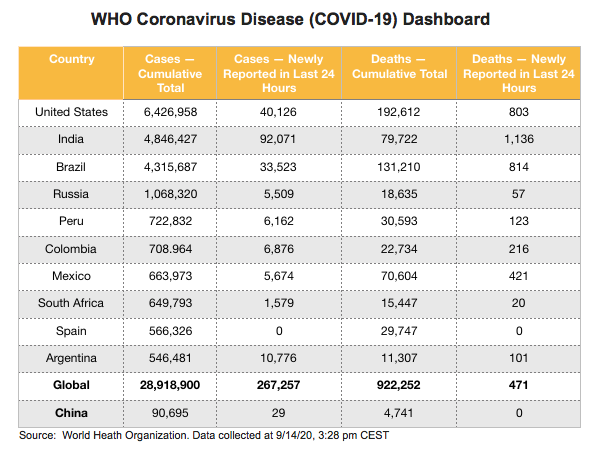
These indicators seem to look better now than in March and April, but economists warn that it’s still too early to assume that stability has returned. Unemployment has come down, but there’s concern over the accuracy of the reporting; and that it’s still way above the 3.5 percent to 4.5 percent rate when the economy is within a stable rate. The GPD being down so dramatically is a significant indicator to follow.
A Wall Street Journal/NBC News poll shows mixed messages on the economy and public perception of it. The current unemployment rate and rising stock prices may be part of what could be recorded as the deepest and shortest downturn after Covid-19 hit the US. An economic recovery has started, but its growth and stability are still unknown; and that recovery is accompanied by large amounts of government borrowing. The opinion poll showed support for President Trump on the economy, but some of those who gave him a good economic leadership rating don’t plan to vote for him in November.
While the three stock market indices are looking better, the stock markets are still going through waves of volatility. Stock performance is expected to stay in the green into the new week. On the other side, it looks like Covid-19 relief spending may not be coming from Washington. Democrats and Republicans are still more than a trillion dollars apart from striking a deal.
As for economic forecasts in the pandemic climate — Global economies are expected to be several quarters away from returning to pre-pandemic levels with Asia seeing its first regional recession in 60 years……… OPEC and BP are predicting oil prices will be staying down for quite a while………. Automakers and their suppliers have been returning to near-normal activity in production plants; engineers and designers are getting back to work on the next-generation electric vehicle propulsion, and autonomous systems are still drawing support with delivery drones and robots getting the most push lately. Amazon, FedEx and other companies are lobbying for favorable regulation as automated e-commerce delivery becomes more popular due to the pandemic.
US consumers did quite a bit of online shopping in the second quarter — increasing 31.8 percent from the previous quarter; and 44.5 percent year over year, according to US Census Bureau of the Dept. of Commerce. That made for $211.51 billion in revenue — up from $160.41 from Q1. But it wasn’t enough to level out the negative impact of numerous losses from brick-and-mortar store closures; and total retail sales were down 3.9 percent from the prior quarter.
Amazon’s recent financial performance ties in closely to the online shopping numbers. The company’s sales skyrocketed 40 percent year-over-year to to $88.9 in its fiscal second year. Profits also doubled year-over-year to $5.2 billion during that quarter. The company also reported spending about $4 billion on Covid-19—related expenses such as adding additional safety measures at the company’s warehouses and facilities, personal protective equipment employees, and $500 million for bonuses to logistics and delivery workers. The company will continue hiring in its fourth round this year — 100,000 workers to meeting growing order and delivery demand; and 33,000 in corporate and tech roles with pay averaging $150,000.
Tech firms are creating new jobs — as employees have been stuck at home, employers have brought in new managers to manage the new, virtual workplace — and to prepare for a lasting remote workplace for many workers. Tech firms like Facebook are doing most of the job postings for jobs such as, “director, remote work.”
US debt last month reached its highest level compared to the size of the economy since World War II and is projected to exceed it next year as the coronavirus pandemic continues on. The Congressional Budget Office reported that federal debt held by the public is projected to reach or exceed 100 percent of US gross domestic product, the broadest measure of U.S. economic output, in the fiscal year that begins on Oct. 1.

Questions have never been clearly answered by California Gov. Gavin Newsom on why reducing the cases and fatalities was so positive for the state in March, but so awful by summer time. California and several other states seemed to be bending to large employers and other interests. But what is the real cost of going this rate in fatalities, medical care and emergency services, and what it may be doing to education and the workplace?
Asian countries are credited with enacting strict social protocols and seeing much lower infection and fatality rates — as shown above in China’s numbers, the country where all of it began in December 2019. The trade war between China and the US has been behind many of the actions taken by both governments this year. Two Chinese companies were hit with trade sanctions last week by the US Commerce Dept., something that continues on a regular basis in the US and China; with the White House citing national security as the reason for restricting exports.
And in other news………..
General Motors is partnering with Nikola to engineer and build the Nikola Badger for both the battery electric vehicle and fuel cell electric vehicle variants. Nikola anticipates saving over $4 billion in battery and powertrain costs over 10 years and over $1 billion in engineering and validation costs. GM expects to gain more than $4 billion of benefits between the equity value of the shares, contract manufacturing of the Badger, supply contracts for batteries and fuel cells, and EV credits retained over the life of the contract. The Detroit automaker’s CEO Mary Barra said Monday that the company conducted “appropriate diligence” in the $2 billion deal with Nikola. That follows fraud claims made last week by short-selling firm Hindenburg Research. But the Securities and Exchange Commission will be examining whether the deal could be violating securities laws.
NGVAmerica’s Annual Industry Summit will transition to an online format for Fall 2020 due to the Covid-19 pandemic, which will go online Oct. 20th to 22nd from 12:00 p.m. to 3 p.m. ET daily. Registration for the virtual sessions is now officially open at NGVShow.com. On-road, off-road and everything in between will be featured, from traditional freight, refuse, and transit applications to growing marine, rail, and construction use in vehicles powered by natural gas. Program details are being finalized now built around daily themes: Market, Sustainability, and Public Policy.



